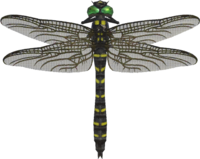Banded dragonfly
- "Yes!!! I caught a banded dragonfly! Look at those stripes!" —Animal Crossing (GCN)
- "I did it! I caught the elusive banded dragonfly!" —Wild World
- "Whoo hoo! Did you see that? Did you? I caught a banded dragonfly!" —City Folk
- "I did it! I caught a banded dragonfly! Now to find the rest of its band!" —New Leaf
- "I did it! Did you see that? I caught a banded dragonfly!" —New Horizons
| ||||||
 | ||||||
| Real-world info | ||||||
|---|---|---|---|---|---|---|
| Name: Anotogaster sieboldii Family: Cordulegastridae - Spiketails | ||||||
| Main appearances | ||||||
|
| ||||||
| Other appearances | ||||||
Names in other languages
Unknown
Unknown Unknown Unknown
Unknown
Unknown Unknown Unknown
Unknown Unknown Unknown Unknown | ||||||
The Banded Dragonfly (オニヤンマ, Oniyanma) is a bug in the Animal Crossing series that can be found between 8 a.m. and 5 p.m. in July and August. It sells for 4,500 Bells, being relatively rare, and can be difficult to catch because of the fast speed at which it flies.
Donating to the museum
When the Banded Dragonfly is donated to the Museum, Blathers will say the following:
In Animal Crossing
"I've heard that Tom Nook pays quite a fair price for specimens such as this. Thank you for your generosity. But all that nonsense aside, this is a colossal dragonfly! Of course, that merely makes it colossally repulsive."'
In Wild World
"Hoo! You caught a banded dragonfly! Most impressive. Rather difficult, was it? Bit of a hairy fellow, wot? I say, some cosmetic plucking would really help..."
In City Folk
"Banded dragonflies are rather flashy... Just look at those piercing green eyes. The black and yellow body! Not to mention their sheer size and--OH, HORRORS! The beast is looking right at me! Look away, fiend!"
It can be found in the first terrace of the insect exhibit, flying near the small pool of water near the flowers. It shares its pool with the Darner Dragonfly.
In New Leaf
Upon being donated, the dragonfly can be found in the first room of the bug exhibit, flying around the pond and occasionally resting on the fence. The exhibit has this to say about the Banded Dragonfly:
"Banded Dragonflies have black-and-yellow-striped bodies and bright-green eyes. They are large and can fly quite fast. They have strong jaws, so it might be painful if you get bitten. Their larval stage lasts two to four years, where they live near water, feeding on tadpoles and small fish."
In New Horizons
"The banded dragonfly is known for its black-and-yellow-striped body, as well as for its piercing green eyes. And it is those very eyes that help make dragonflies master hunters, you see. Alas, when one looks at me, I can't help but feel it is sizing me up for a meal! Hoot! The horrors! Look away, fiend!"
When donated, the banded dragonfly can be found flying around the body of freshwater in the main room of the bug exhibit, alongside the darner dragonfly.
Encyclopedia information
After the player has caught a Banded dragonfly for the first time, they can find information about it in the bug tab of their encyclopedia.
Wild World
| 64px | ''They have tiger stripes and can be hard to catch."
|
City Folk
New Leaf
New Horizons
Further Information
Anotogaster sieboldii, also known as the golden-ringed dragonfly, jumbo dragonfly, Siebold's dragonfly or oniyanma, is the largest dragonfly species in East Asia, with populations in Japan, China, and the Korean Peninsula, and adults often reach lengths between 90 mm and 100 mm. It is characterized by its black and yellow segmented abdomen and thorax and its bright green eyes. Eggs are usually laid by females at the bottom of ponds and creeks a month after metamorphosis, taking about a month to hatch into nymphs, or larvae. As a nymph, it undergoes moulting almost ten times before reaching adulthood — which can often take four to five years; in addition, Anotogaster sieboldii preys upon aquatic wildlife when a nymph and small insects when mature.
More information on this topic is available at Wikipedia.
Names in other languages
| 無霸勾蜓 Unknown |
||
| Кордулегастер Unknown |
From related genus Cordulegaster | |
| Libélula tigre | ||
| Cordulégastre | ||
| Bugs | ||||||||||||||||||||||||||
|---|---|---|---|---|---|---|---|---|---|---|---|---|---|---|---|---|---|---|---|---|---|---|---|---|---|---|
| ||||||||||||||||||||||||||